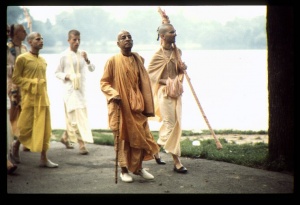CC Madhya 6.135 (1975): Difference between revisions
(Vanibot #0027: CCMirror - Mirror CC's 1996 edition to form a basis for 1975) |
(Vanibot #0020: VersionCompareLinker - added a link to the Version Compare feature) |
||
| Line 2: | Line 2: | ||
<div style="float:left">'''[[Sri Caitanya-caritamrta (1975)|Śrī Caitanya-caritāmṛta (1975)]] - [[CC Madhya (1975)|Madhya-līlā]] - [[CC Madhya 6 (1975)|Chapter 6: The Liberation of Sārvabhauma Bhaṭṭācārya]]'''</div> | <div style="float:left">'''[[Sri Caitanya-caritamrta (1975)|Śrī Caitanya-caritāmṛta (1975)]] - [[CC Madhya (1975)|Madhya-līlā]] - [[CC Madhya 6 (1975)|Chapter 6: The Liberation of Sārvabhauma Bhaṭṭācārya]]'''</div> | ||
<div style="float:right">[[File:Go-previous.png|link=CC Madhya 6.134 (1975)|Madhya-līlā 6.134]] '''[[CC Madhya 6.134 (1975)|Madhya-līlā 6.134]] - [[CC Madhya 6.136 (1975)|Madhya-līlā 6.136]]''' [[File:Go-next.png|link=CC Madhya 6.136 (1975)|Madhya-līlā 6.136]]</div> | <div style="float:right">[[File:Go-previous.png|link=CC Madhya 6.134 (1975)|Madhya-līlā 6.134]] '''[[CC Madhya 6.134 (1975)|Madhya-līlā 6.134]] - [[CC Madhya 6.136 (1975)|Madhya-līlā 6.136]]''' [[File:Go-next.png|link=CC Madhya 6.136 (1975)|Madhya-līlā 6.136]]</div> | ||
{{CompareVersions|CC|Madhya 6.135|CC 1975|CC 1996}} | |||
{{RandomImage}} | {{RandomImage}} | ||
==== TEXT 135 ==== | ==== TEXT 135 ==== | ||
<div class="verse"> | <div class="verse"> | ||
: | :mukhyārtha chāḍiyā kara gauṇārtha kalpanā | ||
: | :'abhidhā'-vṛtti chāḍi' kara śabdera lakṣaṇā | ||
</div> | </div> | ||
| Line 18: | Line 17: | ||
<div class="synonyms"> | <div class="synonyms"> | ||
mukhya-artha—direct meaning; chāḍiyā—giving up; kara—you do; gauṇa-artha—indirect meaning; kalpanā—imagining; abhidhā-vṛtti—the meaning that is understood immediately; chāḍi'-giving up; kara—you do; śabdera—of the words; lakṣaṇā—interpretation. | |||
</div> | </div> | ||
| Line 25: | Line 24: | ||
<div class="translation"> | <div class="translation"> | ||
"For each sūtra the direct meaning must be accepted without interpretation. However, you simply abandon the direct meaning and proceed with your imaginative interpretation. | |||
</div> | </div> | ||
| Line 32: | Line 31: | ||
<div class="purport"> | <div class="purport"> | ||
</div> | </div> | ||
Latest revision as of 18:32, 27 January 2020

His Divine Grace
A.C. Bhaktivedanta Swami Prabhupada
A.C. Bhaktivedanta Swami Prabhupada
TEXT 135
- mukhyārtha chāḍiyā kara gauṇārtha kalpanā
- 'abhidhā'-vṛtti chāḍi' kara śabdera lakṣaṇā
SYNONYMS
mukhya-artha—direct meaning; chāḍiyā—giving up; kara—you do; gauṇa-artha—indirect meaning; kalpanā—imagining; abhidhā-vṛtti—the meaning that is understood immediately; chāḍi'-giving up; kara—you do; śabdera—of the words; lakṣaṇā—interpretation.
TRANSLATION
"For each sūtra the direct meaning must be accepted without interpretation. However, you simply abandon the direct meaning and proceed with your imaginative interpretation.
PURPORT